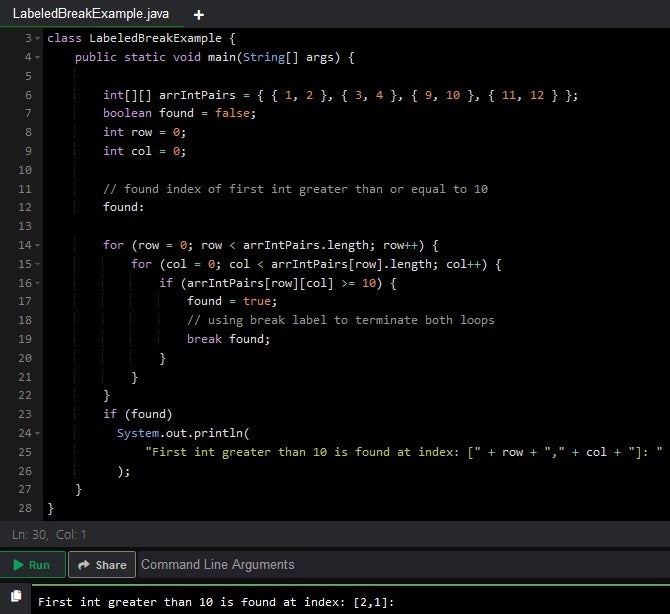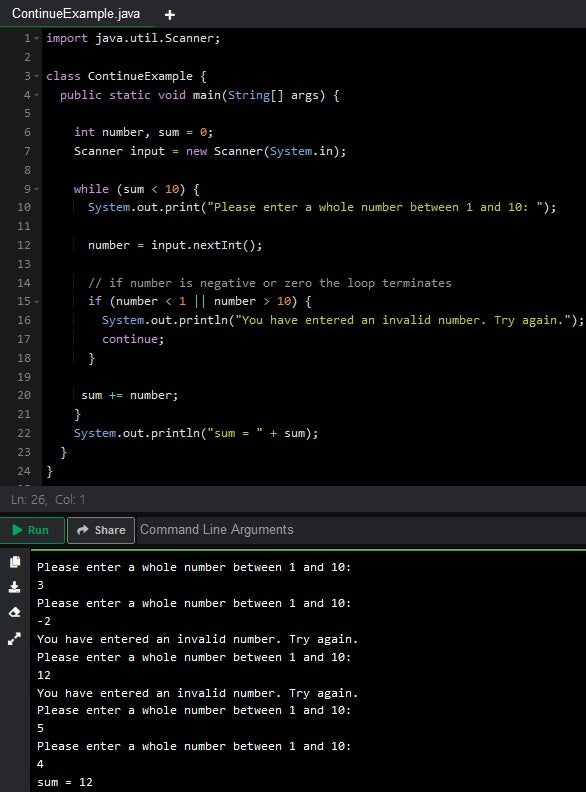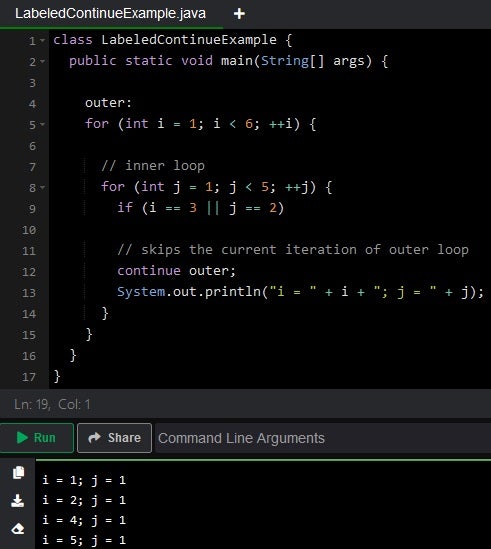Looping is an extremely crucial function of virtually all shows languages, consisting of Java. In reality, it is so crucial that Java supports no less that 4 kinds of loops: While, Do While, For, and For-each We learnt more about the While and Do While loops in a previous tutorial. We then covered the For and For-each loops. You can out those 2 short articles listed below:
Which ever loop you pick to utilize for repeating over a collection or things homes, there might be times that you will require to end the loop right away without examining the test expression, or avoid some declarations inside the loop. To do that, designers can utilize the break and continue declarations. This shows tutorial will show how to utilize the break and continue declarations in Java utilizing code examples to assist bring whatever together.
The break Declaration in Java
In Java, the break declaration is utilized to end loop execution right away. Thus, when a break declaration is experienced inside a loop, the loop model stops there, and the control of the program transfers to the next declaration following the loop. The break declaration works when developers are unsure about the real variety of versions they will require for the loop, or they wish to end the loop based upon some condition.
Many Java tutorials about loops and the break declaration offer a rather contrived example, like the following loop that increments a variable on each model and breaks when the counter variable reaches a particular worth:
for (int i = 0; i < < 10; i++) {
. if (i == 5) {
.
.
break;
.}
.
System.out.println( i);
.
}
.
.
/
* prints
. 0
. 1
. 2
. 3
. 4
. */
.(* )Because the variable
i is never ever going to strike(* )10 and leave the loop generally, the code might quickly be reworded without the break by setting the target i worth to 4 rather of 10 Here is a more reasonable example that presents an aspect of unpredictability by accepting input from the user. The program takes a series of int worths in between 1 and 10, which it sums together. Needs to the user offer a number that falls beyond the defined variety, the break declaration is used to leave the loop and offer the amount at that point: import java.util.Scanner;
.
. class BreakExample {
. public fixed space primary( String(* )args) {
.
.
int number, amount = 0;
. Scanner input= brand-new Scanner (System.in);
.
. while( amount < 10 ){
. System.out.print( "Please go into an entire number in between 1 and
10:" );
.
. number =input.nextInt();
.
<.// if number > is unfavorable or no the loop ends
. if( number < 1|| number > 10) {
.
System.out.println(" You have actually gotten in
a void number. Terminating.");
.
break;
.}
.
. amount+= number;
.}
. System.out.println (" amount="+ amount);
.}
.}
. Here is a screen shot that reveals what a common effective complete run may appear like:
Providing an unfavorable number would activate the [] break
declaration, leading to early termination and a mistake message:

Please go into an entire number in between 1 and 10:
.
4
. Please go into an entire number in between 1 and
10:
.
-1
. You have actually gotten in a void number. Terminating.
. amount= 4
. Utilizing break With a Label in Java When used within embedded loops, the
break
declaration ends the inner loop just:
while( testEpression) {
. while( testEpression) {
.
if( conditionToBreak) {
.
break;
.}
.// more code
.
}
.
// execution continues here after break:
.// more code
.}
. We can utilize the identified break
declaration to end the outer loop also by positioning a label above the loops. Here is a cool program that explores a variety of
int sets and discovers the very first worth of 10 or more. When discovered, the break declaration exits both loops and the outcomes exist to the user in the kind of a comprehensive message: class LabeledBreakExample {
. public fixed space primary( String(* )args) {
.
. int arrIntPairs= {{1, 2}, {3, 4}, {9, 10}, {
11, 12}}
;
.
boolean discovered =incorrect;
. int row= 0;
. int col= 0
;
.
.// discovered index of very first int higher than or equivalent to 10
.
discovered:
.
<. for( row= 0; row < arrIntPairs.length; row++) {
. for( col= 0; col < arrIntPairs
length;
col+
+) {
. if (arrIntPairs
>= 10) {
.
discovered= real;
.
// utilizing break label
to end both loops
. break discovered;
.}
.}
.}
.
if( discovered)
.
System.out.println(
. "Very first int higher than 10 is discovered at index:[]: "
.);
.}
.}
.[][] Here is the complete program in addition to its produced output:[row] Read:[row][col] Finest Task Management Tools for Developers[" + row + "," + col + "] The continue Declaration in Java
Instead of leave the loop, the continue declaration breaks one model of the loop and continues with the next loop model.

Here is the really first example that we saw today utilizing a continue
instead of
break
: for (int i =0;
i < 10;
i
++) {
. if( i==
5
) {
.
.
continue;
.
}
.
.
System.out.println( i);
.}
./ * prints
. 0
. 1
. 2
. 3
. 4
. 6
. 7
. 8
. 9
. */
. Utilizing continue(* )makes more sense in this context since it does not nullify the loop test. We still desire an overall of 10
versions, while just printing every worth however
5 Designers can refactor the BreakExample program above utilizing the continue (* )declaration so that, rather of terminating when the user goes into a void number worth, we can just request for another:
import java.util.Scanner;
.
. class ContinueExample
{
. public fixed space primary( String
args)
{
.
.
int number, amount = 0;
. Scanner input= brand-new Scanner( System.in);
.
. < while( amount < 10) {
. System.out.print( "Please go into an entire number in between 1 and 10: ");
.
. number= input.nextInt();
.
.// if number is unfavorable or no the loop ends
. if( number < 1|| number > > 10) {
. System.out.println(" You have actually gotten in a void number. Attempt once again.");
.
continue;
.
}
.
. amount + =number;
.
}
. System.out.println (" amount="+ amount);
.}
.}
. Here is the upgraded program and output: The Identified continue Declaration in Java Since JDK 1.5, the(* )continue(* )declaration might likewise be utilized with a label. It can be used to avoid the existing model of an external loop so that the program control goes to the next model of an inner loop. Here is a code example:(* )class LabeledContinueExample {
. public fixed space
primary( String args) {
.
.
external:
. for (< int i= 1;
i < 6;
++ i) {<
.
.// inner loop
. for( int j =1;
j
< 5;+ +j) j== 2)
.
.
// avoids the existing model of external loop
. continue external
;
.
System.out.println( "i =" + i +";
j =" + j);
.
.}
.}
.}
.
We can see in the program output listed below that the model of the external [] for
loop was avoided if either the worth of

i
was 3 or the worth of
j[] was
2: Last Ideas on the Java Break and Continue Statements In this shows tutorial, we discovered how to utilize the Java break and continue declarations, utilizing a number of code examples that assisted bring whatever together. Keep in mind that utilizing the identified continue declaration tends to be prevented since it can make your code hard to comprehend. If you ever discover yourself in a scenario where you feel the requirement to utilize identified

continue
, attempt refactoring your code to carry out the job in a various method while making the code as understandable as possible. Check Out: Tips to Enhance Java Efficiency